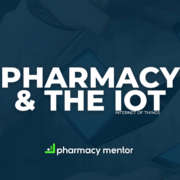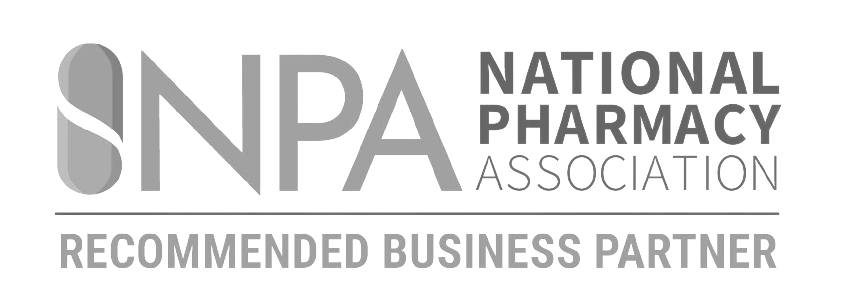Blockchain is next up in our series of articles on how future technologies will impact Pharmacy. In this article, we’ll examine how other industries use Blockchain, how Pharmacy can adopt it, and how its impact will grow as technology advances. For a “Too Long; Didn’t Read” summary, scroll to the bottom.

Blockchain technology is a network of computers storing data transparently.
What is the Blockchain, and how does it work?
Blockchain technology is a network of recorded and verified transactions. It’s an auditor’s dream, because it tracks everything.
From a technical perspective, it’s quite complex, so let me explain it in layman’s terms.
Think of a big notebook that everyone can see, and anyone can add to. Every time someone adds a new note to the notebook, everyone can see it and know that it’s true. No one can change anything that’s already written in the notebook, so everyone knows that the information is secure.
Now imagine that instead of a notebook, we’re talking about a digital ledger. This ledger is stored on many different computers all around the world, and each computer has a copy of the ledger. When someone wants to add a new piece of information to the ledger, they have to get agreement from all the other computers in the network. Once everyone agrees that the new information is valid, it gets added to the ledger and can’t be changed.
This is what blockchain technology is all about – it’s a way of storing information on a network of computers that is secure and transparent. Because the dataset is distributed amongst many different computers, it’s almost impossible for anyone to hack or alter the information. And because everyone on the network can see the same information, there’s no need for a central authority to verify transactions. This is what makes it a powerful tool for all kinds of applications, from finance to healthcare.
How can Pharmacy harness Blockchain in the future?
The most obvious impacts of Blockchain on Pharmacy will be:
- Blockchain Prescriptions
- Increased Data Security
- Audit Trails & Accountability
- Secure supply chain & eliminating counterfeit medicine
Blockchain Prescriptions: A more secure future
Blockchain technology has the potential to enhance prescription security in a number of ways:
- Preventing prescription fraud: By using blockchain to store prescription data, pharmacies and healthcare providers can create a tamper-proof record of prescription information that can’t be easily altered. This prevents prescription fraud and improve patient safety, especially if we transitioned to an electronic-only system. Similar to how Blockchain would prevent a lot of money laundering if we lived in a cashless society. Ironically, with no cash or paper prescriptions, there’s always a “paper trail.”
- Improving prescription tracking: Blockchain can provide a secure and transparent ledger of drug transactions, from production to dispensation, which could improve drug traceability and prevent counterfeit drugs from entering the supply chain.
- Enhancing patient privacy: Pharmacies guarantee that patient data is kept private and secure by using blockchain to store patient prescription data. The security of data and personal information is guaranteed for patients sharing data through blockchain-based systems.
- Streamlining prescription filling: Blockchain would allow quick and secure accessing of patient prescription data, allowing more efficient and accurate dispensing. This reduces errors and improves patient outcomes.
- Compliance with regulations: Using blockchain for storing prescription data means pharmacies comply automatically with regulations and guidelines related to prescription data storage and sharing.
Overall, blockchain technology has huge potential for improving prescription security. It requires significant investment, but the potential benefits for prescription security are more significant.
Increased Data Security
Reece Samani on Protecting Patient Data
Many of the great benefits that Big Data & AI offer have a common issue – data privacy & security.
But Blockchain provides a secure and decentralised database. Blockchain’s resistance to hacking and cyber threats, makes it the solution, protecting patient data and preventing data breaches.
Audit Trails, Authentication & Accountability
Reece Samani on Auditing Telemedicine Prescribing
A big issue within Pharmacy is practitioners going rogue: prescribing without need, overprescribing, under-dispensing and other fraudulent activities.
Blockchain, when combined with the Internet of Things, Big Data & AI, eliminates most, if not all the possibility for this to happen, especially not more than once.
Blockchain technology means that everything anyone does is traced back to them, or their log-in. It also tracks all the medicine across the supply chain, from source to dispensary.
The Big Data of the healthcare network includes the entire history of actions and behaviours by pharmacists across the industry in any particular network (e.g. the NHS).
Artificial Intelligence constantly scans this huge amount of data, learning what are and aren’t “typical” behaviours from pharmacists, suppliers, delivery drivers, you name it.
A fully blossomed Internet of Things links all devices across the same network and monitors activity, further increasing this paperless paper trail of actions.
All of these technologies working together combine in a way where, not unlike The Police’s creepy song about a stalker, every move you make, every step you take, the system is watching you.
It becomes very difficult to break the rules. For an industry which absolutely requires stringent regulation, this is only a good thing.
Secure supply chain & eliminating counterfeit medicine
Blockchain allows the tracking of drug movements all the way from manufacturer to the patient’s doorstep. This helps prevent counterfeit drugs from entering the supply chain and improves drug traceability.
By using blockchain technology, the pharmacy industry can ensure a secure and transparent supply chain, which helps to eliminate the entry of counterfeit medicines into the market. Since blockchain technology tracks every drug’s movement from the manufacturer to the patient’s doorstep, it becomes easy to trace the drug’s origins and detect any signs of tampering or counterfeiting.
Each time a new transaction occurs in the supply chain, it’s added to the blockchain. This creates an immutable record that cannot be altered.
This record includes details like the:
- Date and time of the transaction,
- Parties involved
- Location of the transaction.
So any fraudulent activity can be detected quickly, and the drug can be traced back to its source.
As counterfeit medicines pose a significant threat to public health, ensuring drug traceability using blockchain technology can help prevent these dangerous drugs from entering the supply chain.
TL;DR?
There’s absolutely no question that technology enhances and enables better work from good pharmacists.
Blockchain technology however has enormous potential for reducing bad or illegal practice above all else. Especially regarding prescription security, supply chain transparency, and data security.
By leveraging blockchain technology, pharmacies create a tamper-proof record of prescription data that is secure, transparent, and easily accessible, while also complying with regulatory guidelines and providing better patient outcomes.
Although utilising Blockchain technology presents its own challenges, the potential benefits of blockchain technology for the pharmacy industry are more than worth it.
My only hope throughout writing this series of guides on future technology in Pharmacy is that the industry adopts them faster than they adopted digitisation.







